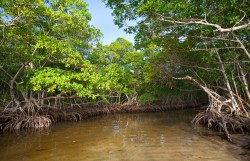
ShutterstockNatural protection against rising seas, or development site in waiting?
Protecting nature is the best way of protecting ourselves from rising tides and storm surges, according to new research.
Sand dunes, wetlands, coral reefs, mangroves, oyster beds, and other shoreline habitats that ring America help to protect two-thirds of the coastlines of the continental U.S. from hurricanes and other such hazards.
Developers see these coastal areas and think — *ding* *ding* *ding* *ding* — opportunity. They want to replace shoreline habitats with waterfront homes, shipping channels, highways, and other delights of urbanism and commerce, along with hulking concrete structures designed to keep the rising seas at bay.
Or, another idea would be to leave nature intact and let it continue to shelter us.
The latter approach would, according to a study published in Nature Climate Change, be the superior option for protecting lives and property in most of the nation’s coastal areas.
Led by Stanford University’s Natural Capital Project, researchers mapped the intensity of hazards posed to communities living along America’s coastlines from rising seas and ferocious storms now and in the decades to come. They examined the hazards those communities would face in the year 2100 with and without the coastal habitats left intact. Here is what they found:
Habitat loss would double the extent of coastline highly exposed to storms and sea-level rise, making an additional 1.4 million people now living within 1 km of the coast vulnerable. The number of poor families, elderly people and total property value highly exposed to hazards would also double if protective habitats were lost.
The research team’s map shows areas where natural systems would be most effective for sheltering lives and properties. From ClimateWire:
The East Coast and Gulf Coast would feel the largest impacts from depleted ecosystems, because they have denser populations and are more vulnerable to sea-level rise and storm surge.
Florida would see the largest increase of people exposed to hazards by 2100 under one sea-level rise scenario highlighted by the researchers. If coastal habitats were preserved, about 500,000 Floridians would face intermediate and high risk from disasters, compared with almost 900,000 people if the habitats disappeared.
New York sees one of the biggest jumps as a percentage of people facing risk under the same scenario. With habitat, a little more than 200,000 people would face high risk, compared with roughly 550,000 people without habitat.
But what’s wrong with building seawalls, levees, and such? Couldn’t such infrastructure allow builders to develop the shorelines safely, keeping rising waters at bay? The paper explains some of the problems with that approach:
In the United States — where 23 of the nation’s 25 most densely populated counties are coastal — the combination of storms and rising seas is already putting valuable property and large numbers of people in harm’s way. The traditional approach to protecting towns and cities has been to ‘harden’ shorelines. Although engineered solutions are necessary and desirable in some contexts, they can be expensive to build and maintain, and construction may impair recreation, enhance erosion, degrade water quality and reduce the production of fisheries.
So let’s maybe thank nature for protecting us by leaving it intact, yeah?



